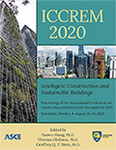International Conference on Construction and Real Estate Management 2020
Research on the Application of Low Impact Development in Green Infrastructure
Publication: ICCREM 2020: Intelligent Construction and Sustainable Buildings
ABSTRACT
With the acceleration of China’s urbanization process, the underlying surface and precipitation runoff of the city have changed a lot and caused increasingly serious problems, such as the deterioration of urban water quality and flood disaster. Among them, non-point source pollution caused by storm runoff has become an important cause of urban water environment deterioration. This paper introduces the importance of the low-impact development mode proposed in this context, its design concept and technical means, discusses its application in the field of green infrastructure on the basis of theory, and seeks for its innovation and development in this field. Finally, it is expected to inspire relevant green infrastructure, sustainable drainage research, and other fields.
Get full access to this article
View all available purchase options and get full access to this chapter.
ACKNOWLEDGMENTS
This article is the stage result of the youth project of the humanities and social science research of Guizhou Education Hall in 2018. The project number: 2018qn10. The name of the project: The research on the system structure and implementation path of the construction of the sponge city in Guizhou province.
REFERENCES
Che, S.Q, and Chen, D. (2015). “Evolution and construction of sponge city theory and technology.” Journal of Chinese Landscape Architecture,31(06), 11-15. (in Chinese).
Hua, J.Z. and Chen, Z.B. (2018).“Construction strategy of sponge city in the old urban area of Kunming based on LID concept.”Journal of Asian Agricultural Research, 10(05), 48-53. (in Chinese).
Ju, M. (2015). “Reflections on sponge city construction concept, technology and policy.” Journal of Water conservancy development research, 15(03), 7-10. (in Chinese).
Tan, S.K. and Zhang, N. (2016). “Evaluation on the status quo of Chinese sponge city construction: Taking 16 sponge cities in China as an example.”Journal of Ur-ban Problems, 35(6), 98-103. (in Chinese).
Wu, D.J., Zhan, S.Z., Li, Y.H., Tu, M.Z., Zheng, J.Y., Guo, Y.Y. and Peng, H.Y. (2016). “Emerging trends and practical research on sponge cities with Chinese characteristics.” Journal of China Soft Science, 12(05), 55-56. (in Chinese).
Wei, T. (2016). “Discussion on sponge city planning methods in response to different rainfall: A case study of controlled detailed planning of urban development area in Shuangliu county, Chengdu.” Journal of Urban Planning, 15(04), 25-26. (in Chinese).
Yu, K.J., Li, D.H., Yuan, H., Fu, W., Qian, Q. and Wang, S.S. (2016). “Sponge City--Theory and Practice.” City Planning Review, 39(6), 26-36. (in Chinese).
Yang, Y. and Lin, G.S. (2015). “Concept and thought of sponge city.” Journal of Southern architecture, 15(03), 59-64. (in Chinese).
Information & Authors
Information
Published In
ICCREM 2020: Intelligent Construction and Sustainable Buildings
Pages: 249 - 254
Editors: Yaowu Wang, Ph.D., Harbin Institute of Technology, Thomas Olofsson, Ph.D., Luleå University of Technology, and Geoffrey Q. P. Shen, Ph.D., Hong Kong Polytechnic University
ISBN (Online): 978-0-7844-8323-7
Copyright
© 2020 American Society of Civil Engineers.
History
Published online: Oct 14, 2020
Published in print: Oct 14, 2020
Authors
Metrics & Citations
Metrics
Citations
Download citation
If you have the appropriate software installed, you can download article citation data to the citation manager of your choice. Simply select your manager software from the list below and click Download.
